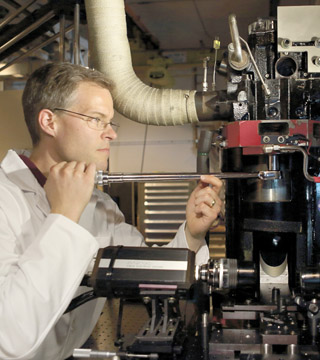
As demand climbs for more fuel-efficient vehicles, knowledge compiled over several years about diesel engines and a new strategy known as “low-temperature combustion” (LTC) might soon lead auto manufacturers and consumers to broader use of cleaner diesel engines in the United States.
The journal Progress in Energy and Combustion Science published a summary of recent research on diesel LTC in a review article titled “Conceptual models for partially premixed low-temperature diesel combustion.” The article, prepared by Mark Musculus, Paul Miles, and Lyle Pickett (all 8362), provides what the authors say is a necessary science base for auto and engine manufacturers to build the next generation of cleaner, more fuel-efficient engines using LTC.
“Diesel engines are generally more efficient than gasoline engines,” says Mark. “When long-haul truck drivers are burning thousands of gallons per year for cross-country freight runs,
or when consumers are faced with high fuel prices, a more efficient engine becomes very important.” The increased efficiency also translates into lower carbon dioxide (CO2) emissions, which are a major driver of global climate change.
Though diesel engines are more efficient, they still have serious pollutant emissions problems.
Gasoline-powered engines have become ever cleaner by inserting better and better catalytic converters between the engine and the tailpipe to clean up pollutants created by the engine.
But the same catalytic converter that works so well for gasoline engines will not work for diesel engines. Other more complicated exhaust aftertreatment systems are deployed in modern diesel engines, but engine designers and operators would like to avoid the cost and efficiency penalties imposed by those systems.
“It would be great to find some other way to clean up the diesel engine if we want to enjoy its full efficiency advantages,” explains Mark, “and LTC might just be the solution.”
Low-temperature combustion reduces NOx and smoke
Largely due to landmark work in the 1980s and 1990s at Sandia’s Combustion Research Facility (CRF) in California, researchers already understand how pollutants are created during conventional diesel combustion. Details of how conventional diesel combustion works — research that took advantage of special optical engines and diagnostics with lasers and scientific cameras to probe the combustion processes — were consolidated into a much-referenced conceptual model developed by Sandia’s John Dec in 1997.
The laser-based diagnostics showed that one pollutant, smoky particulate matter, or PM, was formed in regions where fuel concentrations were too high. Another serious pollutant, nitrogen oxides, or NOx, arose from a high-temperature flame inside the engine. NOx emissions are not only toxic, but once released into the atmosphere and exposed to sunlight, they react with other pollutants to create ground-level ozone, or smog.
LTC addresses the NOx emissions by recirculating some of the exhaust gases expelled by a diesel engine back inside the engine, where they absorb the heat from combustion. With this dilution effect, the combustion temperatures are lower so NOx formation is significantly reduced. The other part of the LTC strategy, Musculus said, is to spray in fuel earlier in the engine cycle to give the fuel more time to mix with air before it burns. LTC thereby avoids much of the fuel-rich regions that lead to PM as well as the high temperatures that lead to NOx.
Breakthrough measurement identifies sources of other pollutants
While LTC helps reduce PM and NOx pollution, it is not without its own problems. While NOx and PM are reduced, other pollutants go up, including carbon monoxide (CO) and unburned hydrocarbons (UHC) from the fuel. Both are not only toxic, but also result in a loss of fuel efficiency.
The CRF research team identified the sources of these emissions from LTC engines using new optical diagnostic techniques. In a breakthrough measurement, researchers used two-photon laser-induced fluorescence to map in-cylinder CO, a difficult measurement that had never been achieved inside a diesel engine.
Detecting UHC is also problematic because many different chemical species make up the overall UHC, and their composition evolves during combustion. So, instead of detecting UHC directly, researchers used laser-induced fluorescence of other markers of combustion, such as formaldehyde and hydroxyl, to observe and understand the chemical processes that lead to UHC. The combined measurements showed that the fuel that ended up near the fuel injector was “over-mixed” — there was too much air and not enough fuel, so the fuel couldn’t burn to completion, leading to the CO and UHC in the exhaust.
With this new understanding of UHC and CO emissions, Mark and former Sandia post-doctoral researcher Jacqueline O’Connor looked for a way to increase the fuel concentration in that area. One way, they discovered, is to add post-injections, which are smaller squirts of fuel after the main spray, which add more fuel in just the right area. With the post-injections, the zone of complete combustion extends over a larger region, leading to lower UHC and CO emissions while increasing efficiency by making sure that less fuel is wasted by not even burning it.
Mark and his colleagues, through their latest research paper, hope to communicate the details of how LTC works to the broader engine research community. “This is the kind of scientific research and data that engine designers, who help to guide our research, tell us they need so that they can build the kind of fuel-efficient diesel engines that consumers will want,” he says.
The Sandia work was completed for the US Department of Energy’s Office of Energy Efficiency and Renewable Energy (EERE).